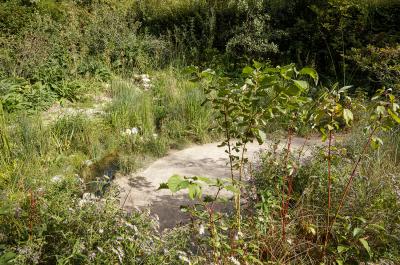09. Brèche

The breach caused by earth movements makes the power that plants possess as actors in resilience visible. It promotes the evolution of spontaneous plant life and the coexistence of different species. Drawing inspiration from flood and flood-recession mechanics on the Loire, the garden provides three environments set around a breach: alluvial forest, mudflats and riverbanks. “It is near water that I have best understood that reverie is an ever-emanating universe”, the philosopher Gaston Bachelard wrote in his essay on the imagination of matter, Water and Dreams.
The plant palette draws its inspiration from the Loire Valley, combining native species adapted to the climate with wild plants. In each environment, an array of three or so plants per stratum is interspersed with surprises, unique isolated features offering themselves up to contemplation. The garden is managed in accordance with the principles of syntropic agriculture developed by Ernst Götsch, a pioneering farmer in Brazil. As far as the living world is concerned, this means striving for ever greater organisation and complexity. This type of management takes account of the issues involved in sustainable development and biodiversity, by combining a wide variety of plants.
Designers

Elisabeth Boscher is an architect qualified to manage projects in her own name (HMONP). She studied at the Paris-La Villette National Higher School of Architecture (ENSA), where she met Sébastien, and at the Technische Universität in Berlin. Among other highpoint in her career, she has worked with Bernard Tschumi and at Atelier Georges, an agency with which she continues to collaborate between Nantes and Montreuil. She extended her field of expertise by taking landscape and garden courses at the National Higher School of Landscape (ENSP) in Versailles, where she met Louise and Lorraine. Her reflections on large territories were rewarded in the context of the Europan international competition, with a project preselected at Session 15 “Productive Cities” and a Special Mention for a project in association with Rerum Architects at Session 16 “Living Cities”. She is committed to a search for frugality, through concrete practice on the ground, close attention to what already exists, and use of local materials to develop desirable, sustainable projects rooted in their territories.
A native of the Anjou region, Louise Grall-Vigneron has enjoyed walking along the banks of the Loire since she was a little girl. She studied literature in preparatory class and then communication at SciencesCom in Nantes. During her years studying for a Master’s degree she cultivated her passion for the art of the image: illustration, video and photography became her favourite tools. In parallel, she reconnected with the pleasure of working outdoors during a civic service mission at the Veni Verdi association. The social potential of gardens, combined with an interest in ecology and living things, persuaded her to continue along the same path and take a course in herbal tea-making at the Neder-over-Heembeek urban farm near Brussels. Finally, in 2022, she enrolled in a continuous training course on Garden Design in the Landscape at the National Higher School of Landscape (ENSP) in Versailles, where she made the acquaintance of Lorraine, Sébastien and Elisabeth, with whom she set up Collectif Brèche. Her approach to garden design calls upon a fantastic imagination that enables her to adopt a range of viewpoints in which human beings are no longer necessarily the central concern. She is guided by her determination to create spaces in which living things can co-exist in harmony – to preserve all an environment’s wealth by ensuring that each of its components is given their fair due. Empathy, inclusiveness and curiosity are the instruments she has chosen to open up the breaches in the concrete.
Born in Nancy in spring 1993, Lorraine Lefort has a degree in Art History from the Louvre School. Her studies there acquainted her with the forms that human creation has taken over the centuries in the world’s various regions, so opening up numerous new possibilities with regard to thinking and doing. Following several months in Nepal, she started work on a Master’s in Photography and Contemporary Art at Paris 8 University (Vincennes-Saint Denis). This provided her with an opportunity to develop visual and theoretical work focusing on the ecology of images, the porosity of symbols, and animism. Her multidisciplinary work combines collage, sound, video, film photography and words. In 2021, her heartfelt desire to improve the daily lives of human beings living in metropolises and her wish to put her creation at the service of living things led her to enrol in a continuous training course at the National Higher School of Landscape (ENSP) in Versailles, where she met Elisabeth, Louise and Sébastien. By thinking of gardens as evolving cosmoses and developing an intimate connection with the environment, she wants to contribute to the decentralisation of western viewpoints resulting from modernity and so enable reconnection with cycles that seem to have disappeared from our lives, encouraging change in the paradigm currently at play, towards a revitalised experience of the world, reconnected to humans and non-humans by empathy and wonder.


